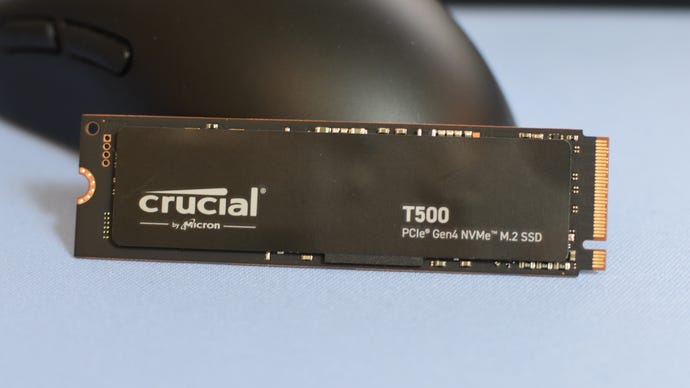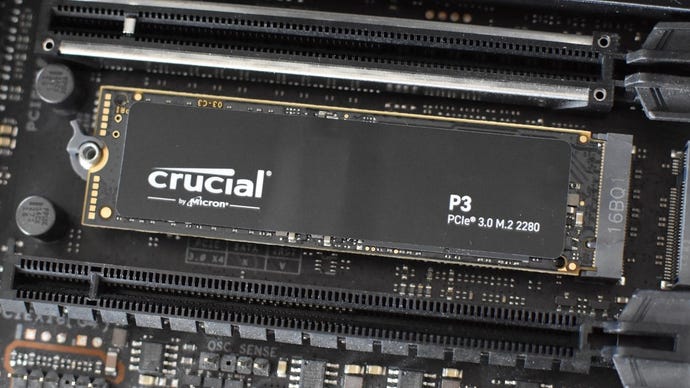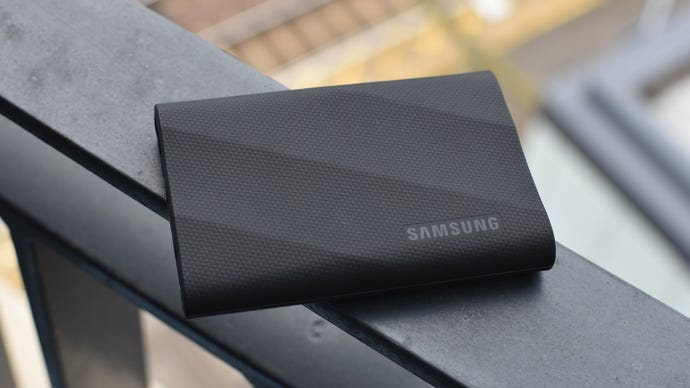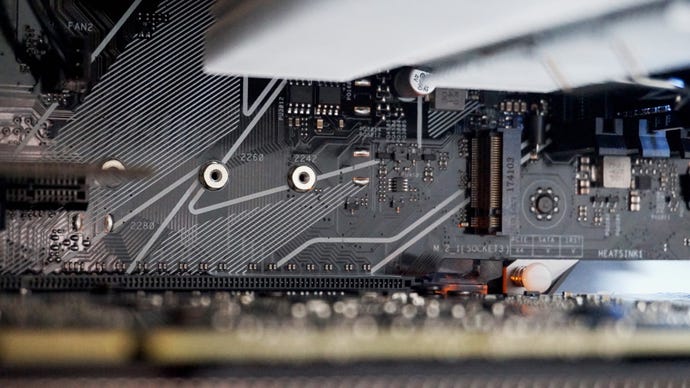Best SSD for gaming: our top SATA and NVMe drives
Our top solid state drive recommendations
Thanks in part to speed-hungry developers, the best SSDs for gaming are more vital upgrades than ever. Which is, let’s be honest, a nicer way of saying that some games just don’t run as smoothly on hard drives as they do on faster solid-states. If they can run at all, that is. No longer are the CPU and graphics card your sole concerns when speccing a PC for performance: nowadays, a good SSD is a must, just as their little cousins microSD cards are essential to the Steam Deck.
Sadly, the rising cost of NAND flash – that’s the physical memory on an SSD that holds all your apps and files – is likely to drive up prices across 2024. Still, don’t let this drive you back into the creaking mechanical arms of archaic HDDs. As much as they suck, swelling prices make a compelling argument for making your storage upgrade ASAP, rather than in a few months when these drives could all be even costlier.
Which would still be a shame, as they’re all top-class SSDs, and have proved it in our range of synthetic and normal-usage benchmark tests. They’ve been arranged by type in the guide below, so you can easily find the exact SSD style your setup needs. For internal drives, say, nothing is faster (or easier to install) than a slimline NVMe/PCIe SSD, though older SATA models might suit tighter budgets. Some of the finest external SSDs are here too, all being ideal for saving game backups and OS recovery images.
I’ll continue refreshing this list in the future, both to add new SSDs (assuming they’re up to standard) and to keep any listed prices as up-to-date as possible. If you’re hoping to save, smaller capacities will obviously cost less, though as modern game install sizes can often exceed 100GB I’d always suggest going as big as your budget will stretch to. Especially if this is going to be the one and only storage drive in your system, in which case aim for 1TB, and definitely don’t drop below 500GB.
Best SSD for gaming
- WD Black SN850X - the best SSD for gaming overall
- WD Blue SN580 - the best cheap SSD for gaming
- Crucial T500 - the best high-end PCIe 4.0 NVMe SSD for gaming
- Crucial P3 - the best SSD for pure PCIe 3.0 speed
- Samsung 870 Evo - the best SATA SSD for gaming
- Samsung 870 Qvo - the best big SATA SSD for gaming
- Crucial X9 Pro - the best external SSD for gaming
- Samsung T9 - the best rugged external SSD for gaming
- Kingston XS2000 - the best USB 3.2 2x2 external SSD for gaming
WD Black SN850X
The best PCIe 4.0 NVMe SSD for gaming

That little 'X' makes the WD Black SN850X look like a mere refresh of the Black SN850. But it’s more of an wide-reaching overhaul than it appears, with higher sequential read/write speeds, faster IOPS (input/output performance), controller improvements, and even a new 4TB model.
Most importantly, the SN850X is much faster in games, with only the Samsung 990 Pro and the Crucial T500 (below) able to catch it. Taking only 6.7 seconds to load a Shadow of the Tomb Raider save, it shaves nearly three seconds off the Black SN850’s time, and clearly beats other premium PCIe 4.0 SSDs like the Kingston Fury Renegade (9.6 seconds) and PNY XLR8 CS3140 (7.3 seconds). In the CrystalDiskMark benchmark, its 3187MB/s random read speed and 4261MB/s random write speed results show an outstanding suitability for games and general PC usage alike.
It's a shame there’s no longer a cheaper 500GB option, as there was for the Black SN850, but the 1TB and 2TB models are at least less expensive than the 990 Pro and T500 equivalents. By wide enough margins, too, that it claims the overall top spot in this list, despite the T500 in particular outpacing it.
What we like:
✔️ Outrageously fast
✔️ Not too expensive (by high-end standards)
✔️ 4TB option
WD Blue SN580
The best NVMe SSD for gaming

With the WD Blue SN580, Western Digital’s excellent Blue series of budget SSDs – see also the Blue SN570 – makes the jump to PCIe 4.0. While this drive doesn’t come close to the top speeds that its new interface is capable of, it crucially maintains that signature Blue affordability, while improving considerably on the SN570’s performance. That older drive scored a 1830MB/s read speed and a 1889MB/s write speed in CrystalDiskMark’s random file benchmark, results that were easily beaten by the SN580’s respective 2317MB/s and 3170MB/s.
Its 8.1s load time in our Shadow of the Tomb Raider test is also good for such a cheap SSD. It’s less than a second slower than quality PCIe 4.0 drives like the Crucial P3 Plus and PNY XLR8 CS3140, and was actually faster than the high-end Kingston Fury Renegade.
Definitely give this a look, then, if you’re building a PC on a budget. The only real caveat is that if you’re looking to upgrade an older rig that still only has PCIe 3.0 support at most, this won’t work, so check out either the Crucial P3 (below) or the older Blue SN570 instead.
What we like:
✔️ High speeds for the money...
✔️ ...which isn't a lot
✔️ Flexible capacity options
Crucial T500
The best high-end PCIe 4.0 NVMe SSD for gaming

When there’s enough cash in your pocket for a proper top-class SSD upgrade, you’ve got two options. The first is to go all the way with a PCIe 5.0 drive, but although these advertise some truly ferocious read/write speeds, these advantages don’t really translate into better games performance. The other (smarter, cheaper, better) option is a PCIe 4.0 model that pushes the interface’s limitations, an excellent example being the Crucial T500.
In most of our benchmarks, this was even faster than the WD Black SN850X; the AS SSD 4K transfer test, for instance, had the T500 score a 90MB/s read speed, soaring over the SN850X’s 57MB/s. It also completed the game file copying test in 0.34s, a new record that easily beats the 0.86s of the SN850X and the 0.97s of the Samsung 990 Pro.
Speaking of Samsung’s prestige SSD, the T500 also managed to match its Shadow of the Tomb Raider loading time of 6.6s, the only drive I’ve tested – including the PCIe 5.0-based Crucial T700 – to do so. Since the T500 also posts consistently higher read speeds than the 990 Pro, in practical terms you can consider it the new fastest gaming SSD around. It would be the best outright, in fact, were it not for the SN850X’s lower pricing.
What we like:
✔️ Joint-best load times on the market
✔️ Higher speeds in non-gaming tasks than rivals
✔️ Optional heatsink (tested without)
Crucial P3
The best SSD for pure PCIe 3.0 speed

Even it doesn’t match the WD Blue SN570 on overall value, there’s still a good reason to choose the Crucial P3 instead: in certain scenarios, it’s the outright fastest PCIe 3.0 SSD we’ve tested.
Like its PCIe 4.0 cousin, the P3 Plus, the P3 is a particularly pacy writer, even outperforming some 4.0 SSDs with its CrystalDiskMark write speed result of 3022MB/s. But it’s also impressively effective in the kind of tricky read tasks that games rely on, as seen in its excellent AS SSD 4K read speed of 57.9MB/s. When the time came to load up Shadow of the Tomb Raider, it did so in just 7.5s, a mere fraction of a second slower than the P3 Plus' 7.3s – and faster than any other PCIe 3.0 SSD so far.
If you’ve yet to upgrade to a PCIe 4.0-ready setup, then, the Crucial P3 is more or less the next best thing.
What we like:
✔️ Immense speeds for its interface
✔️ Widely compatible
✔️ Still not too pricey
Samsung 870 Evo
The best SATA SSD for gaming

When it comes to buying an SSD for gaming, a lot people still opt for a 2.5in SATA drive rather than a super fast NVMe SSD, if only because the latter tend to be quite expensive and you need a motherboard that supports them. For SATA SSD hunters, then, the Samsung 870 Evo is hands down the best drive for the job right now. Its everyday speeds aren't that much faster than its predecessor, the 860 Evo, but with that drive becoming increasingly difficult to get hold of, the 870 Evo is now our SATA SSD of choice for those.
In fairness, Crucial's MX500 is another good budget option for SATA buyers, but when prices for the 870 Evo are only a fraction more these days, there's little point opting for the MX500 unless you can find it for a substantial discount. What's more, the 870 Evo also comes with a much higher endurance rating than the MX500: 300 terabytes written (TBW) for the 500GB model as opposed to just 180TBW on the 500GB MX500. It's fast, durable, and yet to be beaten on overall value.
What we like:
✔️ The fastest SATA drive you can buy today
✔️ Great endurance levels
✔️ Better value for money than the competition
Read more in our Samsung 870 Evo review
Samsung 870 Qvo
The best big SATA SSD for gaming

In fact, there is one SSD with faster write speeds than the Samsung 860 Evo, and that's Samsung's 870 Qvo. Made from 4-bit MLC V-NAND instead of 3-bit MLC like its Evo counterparts, the 870 Qvo is much better value than Samsung's equivalent Evo drives. Its performance is more or less identical, and it's a heck of a lot cheaper, too. As such, if you're looking to get an SSD that's at least 1TB in size but don't want to fork out loads of cash (either on an expensive NVMe SSD or a high capacity SATA drive), the 870 Qvo is the way to go.
Like the rest of Samsung's drives, the 870 Qvo has exceptional endurance ratings and warranties, and its random read and write times are up there with the very best. Plus, if you've got enough cash, you can buy one that's a whopping 8TB - which is practically unheard of in SATA circles. It's still not as cheap as buying a large hard disk drive, but it's the best you're going to get on an SSD.
What we like:
✔️ Excellent everyday performance
✔️ Brilliant value for money
✔️ Just as fast as Samsung's Evo SSDs
Read more in our Samsung 870 Qvo review
Crucial X9 Pro
The best external SSD for gaming

Heir to old RPS favourite, the Crucial X8, the Crucial X9 Pro is a smaller, lighter, and faster external SSD that also breaks away from more expensive contemporaries. It produced some excellent sequential speeds in the AS SSD benchmark, with 986MB/s for reads and 899MB/s for writes, and it smashed the game copying test in just 2.5s (or 550MB/s).
The only disappointment is that the included cable is strictly USB-C to USB-C; a USB-A adapter in the box would have made this an even better package, though since the X9 Pro is already well-priced for its performance, buying a separate cable wouldn’t be the worst thing. It’s obviously not an issue at all if your PC has a spare USB-C port, it's just that full-size USB-A ports are more plentiful.
I’ve also tried out the Crucial X10 Pro, which is physically similar to the X9 Pro save for much higher sequential transfer speeds and a moody black paint job. The X10 Pro was even quicker in the AS SSD game copy test as well, finishing in just 1.78s (778MB/s). It’s evidently a good alternative if you’ve got the money, although I’d still say the X9 Pro is more deserving of this spot on the list: despite being a fair bit cheaper than the X10 Pro, this almost matched the latter's performances in the random 4K file benchmarks. These tests are both more punishing on the drive, and more reflective of the speeds you’d get in real life, compared to easy sequential benchmarks.
What we like:
✔️ Great speeds in tough transfers
✔️ Simple, lightweight design
✔️ Agreeable pricing
Samsung T9
The best rugged external SSD for gaming

The lack of moving parts makes SSDs naturally more impact-resistant than hard drives, which is helpful if you’re likely to keep one in a packed bag, or on a high shelf next to a block of improperly refrigerated butter. For even more protection, something like the Samsung T9 is great – its aluminium shell is enrobed in rubber, producing a considerable upgrade to durability (as well as a lovely matte feel).
The T9 is actually booting another Samsung SSD, the T7 Shield, off its spot in this list. The latter is still a brilliant external SSD, and a more affordable one too, but it can’t stand up to the T9’s speeds. Over a USB-C Gen 2 2x2 connection, the newer model finished AS SSD’s game copying test in an unbelievable 0.62s – a fraction of the 4.16s managed by the T7 Shield. The T9 also nearly doubled the T7 Shield’s sequential transfer speeds, with 1753MB/s reads and 1661MB/s writes.
These two ruggedised drives are much closer on performance if you use a slower USB-C port, or most kinds of USB-A ports. For an external SSD that’s all about shunting files to and from a separate drive, though, the T9’s toweringly high speed ceiling makes it worth the premium.
What we like:
✔️ Tough, but compact
✔️ Fastest transfer speeds around
✔️ Both USB-A and USB-C cables included
Kingston XS2000
The best USB 3.2 2x2 external SSD for gaming

Portable SSDs are tied up in a lot of silly naming conventions for USB standards, like how “USB 3.2 Gen 1” is basically just USB 3.1. All you need to know about USB 3.2 2x2 is that it’s the fastest USB standard you can currently expect to find supported by gaming motherboards, at least until USB4 adoption picks up.
Granted, even USB 3.2 2x2 mobos are still pretty rare, and I don’t recommend the Kingston XS2000 if you’re going to limit it to lower USB 3.2 Gen 2 speeds. But if you do have 2x2 hardware, you’re in for a treat, as this wonderfully pocket-friendly SSD can more than match its advertised sequential speeds while flying through more challenging read and write tasks. In the AS SSD copy benchmark, it completed the game copying portion in 1.21s, or at 1138MB/s; the Crucial X8’s best showing, over USB 3.2 Gen 2, was 3.3s / 420MB/s.
What we like:
✔️ Exceptionally fast over USB 3.2 2x2
✔️ Very small and light
✔️ Bundled with protective sleeve
Frequently asked questions
SATA SSD vs NVMe: what's the difference?
SSDs are split into two main types right now: SATA drives and NVMe drives. 2.5in SATA SSDs are the easiest drop-in replacement for a standard hard disk. These plug into a SATA 3 port on your motherboard, and most modern PC cases have mounting points for 2.5in SSDs on the back of the motherboard tray. If yours doesn't, you can use a cheap adaptor (really just a 3.5in-wide metal plate with screw holes) to fit the SSD in a normal 3.5in hard disk bay. The SATA 3 interface has been around since 2009. It's several times faster than a mechanical hard disk, but it's also not really quick enough to keep pace with the very fastest SSDs that are around today.
If you're in the market for a super-fast SSD that won't be encumbered by its interface, you need to move beyond SATA to NVMe (also called PCI Express, PCIe NVMe, or just NVMe). Most NVMe SSDs are are just 22mm wide and 80mm long (so about a third shorter than a stick of RAM) and are mounted directly to the motherboard in an M.2 slot, so no more having to route SATA and power cables around your case. If your motherboard doesn't have such a slot, there's only one way to unleash the speed: a PCIe add-in card (AIC). These add-in cards will fit in a spare PCIe x4 or x16 slot and are monstrously quick, as well as monstrously expensive.

What's the difference between PCIe 3.0 and PCIe 4.0 SSDs?
Like many different kinds of technology, the PCI Express (PCIe for short) interface has had many different generations over the years. Most new CPUs and motherboards these days provide PCIe 4.0 support, though PCIe 3.0 is still very widely used, hence why 3.0 SSDs are still releasing. The main difference between them is the amount of bandwidth they have to move data back and forth between different parts of your PC.
Bandwidth doubles every generation. PCIe 3.0 currently has a bandwidth of 32GB/s, as well as a bit or data rate of 8 gigatransfers per second (GT/s). However, PCIe 4.0 doubles that to a bandwidth of 64GB/s and a bit rate of 16 GT/s, making it much, much faster at moving large quantities of data around.
What size SSD should I buy?
The minimum SSD size I'd recommend these days is 500GB, as this will give you enough room for your Windows installation (around 20GB), a few big games, plus all your music, photos and any other programmes you might need. However, if you have a particularly large photo and music collection, or just like having lots of games installed at the same time, then I'd recommend bumping it up to the 1TB mark.
To get the most gigs for your money, you could get a smaller SSD - even as little as 256GB - as your main drive and augment it with a 1TB or 2TB hard drive. Just remember, though, that any games or apps saved on the HDD won't benefit from the SSD's much faster speed. I'd still suggest going for the biggest SSD that your budget will allow.









